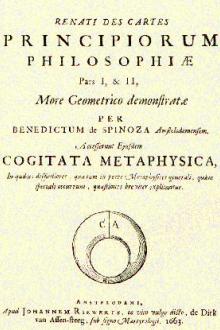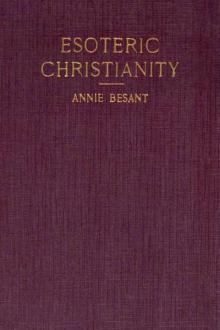Death - and After? by Annie Besant (dark books to read txt) 📖

- Author: Annie Besant
Book online «Death - and After? by Annie Besant (dark books to read txt) 📖». Author Annie Besant
It is not improbable that other sentient beings have organs
of sense which do not respond to some or any of the rays to
which our eyes are sensitive, but are able to appreciate
other vibrations to which we are blind. Such beings would
practically be living in a different world to our own.
Imagine, for instance, what idea we should form of
surrounding objects were we endowed with eyes not sensitive
to the ordinary rays of light, but sensitive to the
vibrations concerned in electric and magnetic phenomena.
Glass and crystal would be among the most opaque of bodies.
Metals would be more or less transparent, and a telegraph
wire through the air would look like a long narrow hole
drilled through an impervious solid body. A dynamo in active
work would resemble a conflagration, whilst a permanent
magnet would realise the dream of mediaeval mystics, and
become an everlasting lamp with no expenditure of energy or
consumption of fuel.[18]
Kamaloka is a region peopled by intelligent and semi-intelligent entities, just as our own is thus peopled; it is crowded, like our world, with many types and forms of living things, as diverse from each other as a blade of grass is different from a tiger, a tiger from a man. It interpenetrates our own world and is interpenetrated by it, but, as the states of matter in the two worlds differ, they co-exist without the knowledge of the intelligent beings in either. Only under abnormal circumstances can consciousness of each other's presence arise among the inhabitants of the two worlds; by certain peculiar training a living human being can come into conscious contact with and control many of the sub-human denizens of Kamaloka; human beings, who have quitted earth and in whom the kamic elements were strong, may very readily be attracted by the kamic elements in embodied men, and by their help become conscious again of the presence of the scenes they had left; and human beings still embodied may set up methods of communication with the disembodied, and may, as said, leave their own bodies for awhile, and become conscious in Kamaloka by the use of faculties through which they have accustomed their consciousness to act. The point which is here to be clearly grasped is the existence of Kamaloka as a definite region, inhabited by a large diversity of entities, among whom are disembodied human beings.
From this necessary digression we return to the particular human being whose fate, as a type, we may be said to be tracing, and of whose dense body and etheric double we have already disposed. Let us contemplate him in the state of very brief duration that follows the shaking off of these two casings. Says H.P. Blavatsky, after quoting from Plutarch a description of the man after death:
Here you have our doctrine, which shows man a _septenary_
during life; a _quintile_ just after death, in Kamaloka.[19]
Prana, the portion of the life-energy appropriated by the man in his embodied state, having lost its vehicle, the ethereal double, which, with the physical body, has slipped away from its controlling energy, must pass back into the great life-reservoir of the universe. As water enclosed in a glass vessel and plunged into a tank mingles with the surrounding water if the vessel be broken, so Prana, as the bodies drop from it, mingles again with the Life Universal. It is only "just after death" that man is a quintile, or fivefold in his constitution, for Prana, as a distinctively human principle, cannot remain appropriated when its vehicle disintegrates.
The man now is clothed, but with the Kama Rupa, or body of Kama, the desire body, a body of astral matter, often termed "fluidic," so easily does it, during earth-life, take any form impressed upon it from without or moulded from within. The living man is there, the immortal Triad, still clad in the last of its terrestrial garments, in the subtle, sensitive, responsive form which lent it during embodiment the power to feel, to desire, to enjoy, to suffer, in the physical world.
When the man dies, his three lower principles leave him for
ever; _i.e._, body, life, and the vehicle of the latter, the
etheric body, or the double of the living man. And then his
four principles--the central or middle principle (the animal
soul or Kama Rupa, with what it has assimilated from the
lower Manas) and the higher Triad--find themselves in
Kamaloka.[20]
This desire body undergoes a marked change soon after death. The different densities of the astral matter of which it is composed arrange themselves in a series of shells or envelopes, the densest being outside, shutting the consciousness away from all but very limited contact and expression. The consciousness turns in on itself, if left undisturbed, and prepares itself for the next step onwards, while the desire body gradually disintegrates, shell after shell.
Up to the point of this re-arrangement of the matter of the desire body, the post-mortem experience of all is much the same; it is a "dreamy, peaceful semi-consciousness," as before said, and this, in the happiest cases, passes without vivid awakening into the deeper "pre-devachanic unconsciousness" which ends with the blissful wakening in Devachan, for the period of repose that intervenes between two incarnations. But as, at this point, different possibilities arise, let us trace a normal uninterrupted progression in Kamaloka, up to the threshold of Devachan, and then we can return to consider other classes of circumstances.
If a person has led a pure life, and has steadfastly striven to rise and to identify himself with the higher rather than the lower parts of his nature, after shaking off the dense body and the etheric double, and after Prana has re-mingled with the ocean of Life, and he is clothed only with the Kama Rupa, the passional elements in him, being but weak and accustomed to comparatively little activity, will not be able to assert themselves strongly in Kamaloka. Now during earth-life Kama and the Lower Manas are strongly united and interwoven with each other; in the case we are considering Kama is weak, and the Lower Manas has purified Kama to a great extent. The mind, woven with the passions, emotions, and desires, has purified them, and has assimilated their pure part, absorbed it into itself, so that all that is left of Kama is a mere residue, easily to be gotten rid of, from which the Immortal Triad can readily free itself. Slowly this Immortal Triad, the true Man, draws in all his forces; he draws into himself the memories of the earth-life just ended, its loves, its hopes, its aspirations, and prepares to pass out of Kamaloka into the blissful rest of Devachan, the "abode of the Gods", or as some say, "the land of bliss". Kamaloka
Is an astral locality, the Limbus of scholastic theology, the
Hades of the ancients, and, strictly speaking, a _locality_
only in a relative sense. It has neither a definite area, nor
boundary, but exists _within_ subjective space, _i.e._, is
beyond our sensuous perceptions. Still it exists, and it is
there that the astral _eidolons_ of all the beings that have
lived, animals included, await their _second death_. For the
animals it comes with the disintegration and the entire
fading out of their astral particles to the last. For the
human _eidolon_ it begins when the Atma-Buddhi-Manasic Triad
is said to "separate" itself from its lower principles or the
reflection of the ex-personality, by falling into the
Devachanic state.[21]
This second death is the passage, then, of the Immortal Triad from the kamalokic sphere, so closely related to the earth sphere, into the higher state of Devachan, of which we must speak later. The type of man we are considering passes through this, in the peaceful dreamy state already described, and, if left undisturbed, will not regain full consciousness until these stages are passed through, and peace gives way to bliss.
But during the whole period that the four principles--the Immortal Triad and Kama--remain in Kamaloka, whether the period be long or short, days or centuries, they are within the reach of the earth-influences. In the case of such a person as we have been describing, an awakening may be caused by the passionate sorrow and desires of friends left on earth, and these violently vibrating kamic elements in the embodied persons may set up vibrations in the desire body of the disembodied, and so reach and rouse the lower Manas, not yet withdrawn to and reunited with its parent, the Spiritual Intelligence. Thus it may be roused from its dreamy state to vivid remembrance of the earth-life so lately left, and may--if any sensitive or medium is concerned, either directly, or indirectly through one of these grieving friends in communication with the medium--use the medium's etheric and dense bodies to speak or write to those left behind. This awakening is often accompanied with acute suffering, and even if this be avoided, the natural process of the Triad freeing itself is rudely disturbed, and the completion of its freedom is delayed. In speaking of this possibility of communication during the period immediately succeeding death and before the freed Man passes on into Devachan, H.P. Blavatsky says:
Whether any living mortal, save a few exceptional cases--when
the intensity of the desire in the dying person to return for
some purpose forced the higher consciousness _to remain
awake_, and, therefore, it was really the _individuality_,
the "Spirit", that communicated--has derived much benefit
from the return of the Spirit into the _objective_ plane is
another question. The Spirit is dazed after death, and falls
very soon into what we call "pre-devachanic
unconsciousness."[22]
Intense desire may move the disembodied entity to spontaneously return to the sorrowing ones left behind, but this spontaneous return is rare in the case of persons of the type we are just now considering. If they are left at peace, they will generally sleep themselves quietly into Devachan, and so avoid any struggle or suffering in connection with the second death. On the final escape of the Immortal Triad there is left behind in Kamaloka only the desire body, the "shell" or mere empty phantom, which gradually disintegrates; but it will be better to deal with this in considering the next type, the average man or woman, without marked spirituality of an elevated kind, but also





Comments (0)